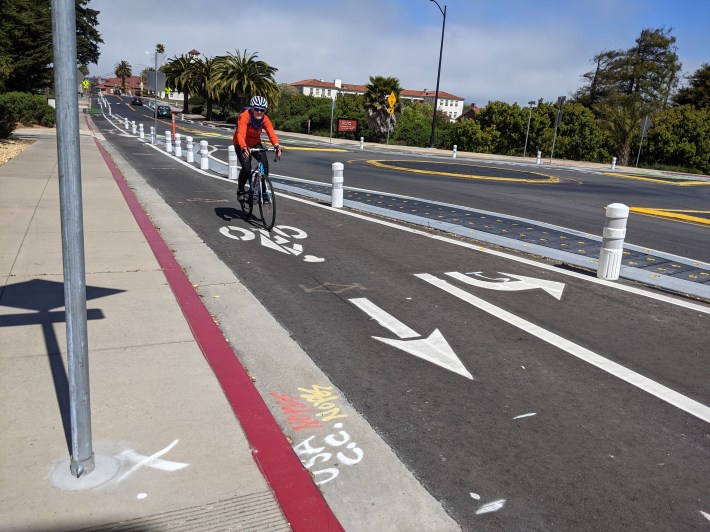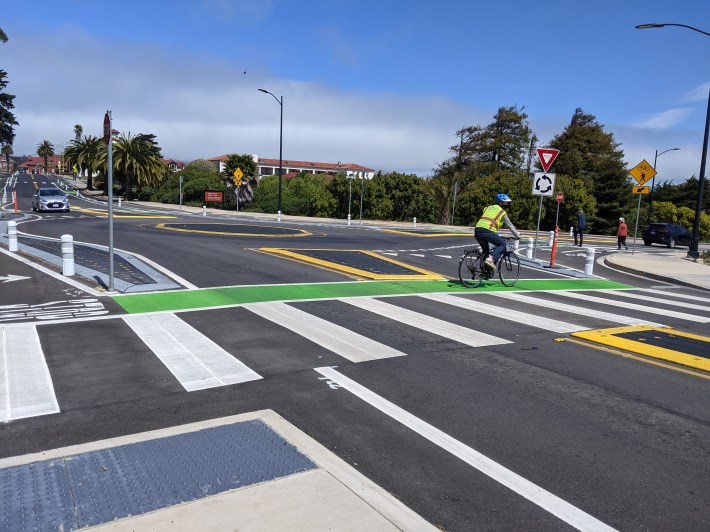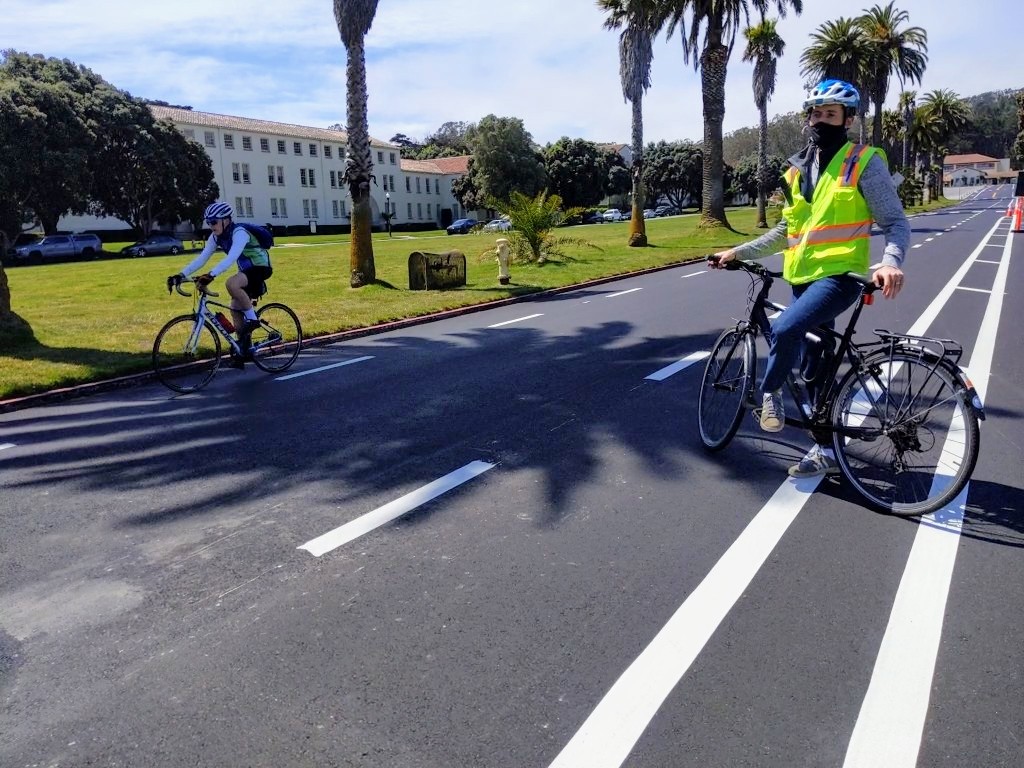Note: GJEL Accident Attorneys regularly sponsors coverage on Streetsblog San Francisco and Streetsblog California. Unless noted in the story, GJEL Accident Attorneys is not consulted for the content or editorial direction of the sponsored content.
Another Dutch-style road treatment can be experienced as of last week in the Presidio: an "Advisory Bike Lane" on Graham Street on the Main Post. From the Presidio's transportation office:
Advisory Bike Lanes are used on narrow, low-volume, and low-speed roads, common to the Presidio. Vehicles share the center lane while bicyclists use the bicycle lanes on each side. When two cars traveling in opposite directions approach each other, they merge into the bike lane to pass, yielding to any cyclists who are present. This is similar to entering a bike lane to make a right turn, a common practice. The Trust expects yielding and passing maneuvers to be rare due to the low vehicle volume on Graham Street.
“Advisory Bike Lanes are a way of making biking safer and more comfortable without reducing access by people who need to drive, such as folks with mobility challenges. We’re very excited to be a part of this innovative study,” said Jean Fraser, CEO of the Presidio Trust, in a prepared statement. The configuration allows for two-way travel by people biking and driving, and also keeps parking on one side of the street to maintain accessible parking for visitors and tenants.

Matt Starkey, the Presidio’s transportation engineer seen on the right in the lead image, said they will be installing video cameras and tracking speeds now that the installation is done. They also want to check passing distances and review close calls.
A study by the Mineta Transportation Institute found that "this treatment reduces crashes by about 44 percent," he said. He also said that on paper (or in the diagram above) it looks like a strange set up, since motorists are positioned for a head-on collision. But, he said, it encourages motorists to drive much more slowly and cautiously.
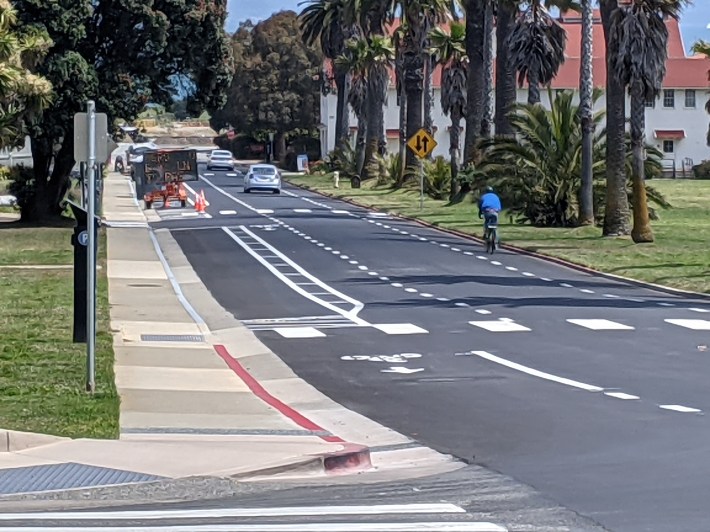
Starkey said it's a much better option than the dreaded sharrow in these specific circumstances. (Streetsblog wants to double underline that, just like sharrows, advisory lanes have no place on busy streets in places such as SoMa).
More from the Presidio's statment:
The Trust is partnering with the Federal Highway Administration (FHWA) to pilot California’s first ever Advisory Bike Lanes. Used extensively in Europe to increase the safety and comfort of people biking, Advisory Bike Lanes have been installed in thirty to forty sites in North America, but not in California. The results of the two-year pilot test will be used to inform the formal adoption by the Federal Highway Administration nationwide. Graham Street was selected for the study because of its relatively low number of cars.
The Presidio also provided this video from Ottawa, Canada to show how the lanes work:
Meanwhile, the Presidio is tweaking another first in San Francisco--its traffic circle with a protected bike lane at Lincoln and Girard (see this March story for background). Concrete parking blocks designed for trucks were added to the approaches on Lincoln Blvd. to make sure errant motorists don't wander into the bike lanes.
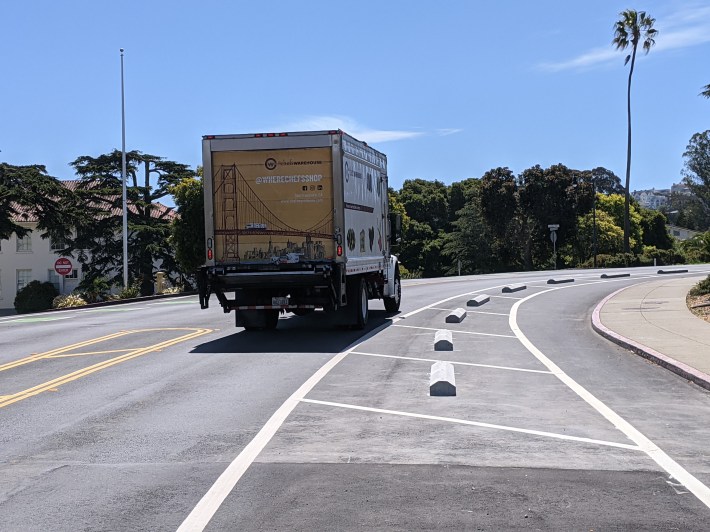
Starkey said the blocks are big enough to redirect motorists in large vehicles that wander into the lane, in addition to looking "army chic" and fitting in with the military history of the Presidio. The bike lanes are also wide enough for two cyclists to ride side-by-side comfortably.
In addition, K-71 hit posts were added to the traffic circle itself.
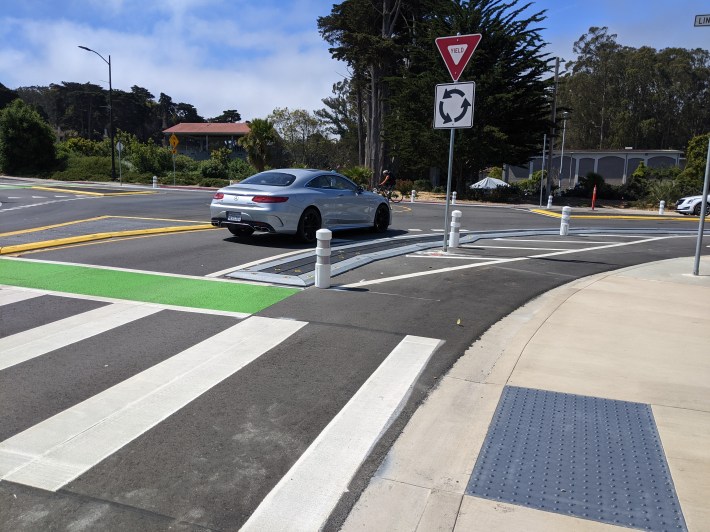
Meanwhile, Starkey said he's taken some heat about the stop signs that give priority to motorists turning from Lincoln to Girard. This is a departure from best practices in the Netherlands, as is the near ninety-degree turn for cyclists.

He said this is something they're still working out. In practice, from Streetsblog's test ride this morning, motorists (who can't see that cyclists have a stop sign) yielded for bikes. Experienced cyclists, meanwhile, jogged around these turns and joined the regular flow of traffic to move straight along Lincoln, while turning and (seemingly) less experienced cyclists used the protected lane. It remains to be seen if the design needs some future modification, such as removing the stop sign and adding yield markings for motorists.
Either way, it's nice to see the Presidio pioneering these treatments. Transportation officials from the cities around the Bay Area should make an effort to come check it out.
More photos of the traffic circle below:
